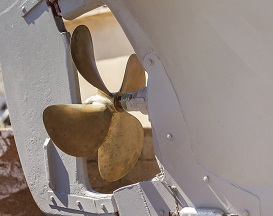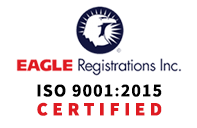Propeller Cavitation Solutions
Contact Quality Castings for Propeller Cavitation Repairs and Investment Cast Replacement Propellers
What causes propeller cavitation?
Propeller cavitation occurs when the pressure around the propeller drops below the vapor pressure of the water, causing vapor bubbles or cavities to form which prevent your propeller from performing at its best.
Propeller cavitation can be caused by:
-
Propeller design issues like improper diameter, engine rpm and static pressure around the blades
-
High rotational speed resulting in low-pressure regions on the blade surfaces
-
Improper propeller design with sharp leading edges, thin blades, or incorrect blade shape
-
Incorrect propeller size or pitch leading to excessive loading
-
Overloading a boat with excessive weight beyond its recommended capacity, causing the engine to struggle
-
Improper adjustment of the boat’s trim angle can create an unbalanced load on the propeller
-
Rough water conditions causing temporarily pressure fluctuations around the propeller
-
Ventilation issues where air or exhaust gas is drawn into the propeller's path
-
Propeller damage such as bent or nicked blades, creating an uneven flow
-
Depth and clearance issues such as operating the boat in shallow waters or at improper depths
-
Fouling and marine growth resulting in a dirty propeller causing higher drag
Effects of Propeller Cavitation
Propeller cavitation causes bubbles or cavities to form on the propeller blades, resulting in reduced propeller performance, increased noise and potential damage to the propeller over time.
Propeller cavitation can result in:
-
Reduced thrust and decreased performance
-
Increased noise, commonly referred to as "cavitation noise", which is disruptive and can indicate efficiency issues
-
Vibration and strain causing increased vibration and strain on the propeller, drivetrain and surrounding components, which can lead to premature wear and failure.
-
Reduced fuel efficiency
-
Erosion and pitting of the propeller’s surface over time
-
Reduced maneuverability and responsiveness
-
Damage to propeller and surrounding components like the shaft and strut
-
Reduced lifespan from damage and erosion
-
Impaired flow of cooling water to the engine and other components, potentially leading to overheating issues
-
Increased maintenance and repair costs
-
Safety Concerns: In extreme cases, cavitation can compromise the structural integrity of the propeller, leading to a risk of catastrophic failure.
Types of Propeller Cavitation
There are two common forms of propeller cavitation: inertial and non-inertial cavitation. Inertial cavitation occurs when severely low pressure causes a rupture and forms a cavity, while non-inertial cavitation occurs when a bubble in fluid oscillates from energy input.
The main types of propeller cavitation are:
-
Tip Cavitation: Tip cavitation occurs at the outermost tips of the propeller blades. It is commonly seen during high-speed operations when the pressure drops significantly at the tip, leading to the formation of cavities.
-
Face Cavitation: Face cavitation occurs on the face of the propeller blade, especially near the leading edge. Face cavitation is more likely to occur when the propeller is not properly aligned with the flow, causing pressure imbalances.
-
Hub Cavitation: Hub cavitation happens around the hub of the propeller, where the blades connect. Hub cavitation can be caused by excessive rotational speed or improper design, leading to pressure drops and cavities forming near the hub area.
-
Vortex Cavitation: Vortex cavitation occurs when vortices are generated near the trailing edge of the propeller blades. The vortices can create areas of low pressure, resulting in cavitation.
-
Sheet Cavitation: Sheet cavitation involves the formation of a continuous sheet or bubble layer along the span of the propeller blades. Sheet cavitation is typically seen during high-speed operations in turbulent flow conditions.
-
Cloud Cavitation: Cloud cavitation is characterized by the presence of small, dispersed cavitation bubbles across the surface of the propeller blades. Sheet cavitation can occur in various conditions, including in situations where the propeller is operating at its peak efficiency.
-
Supercavitation: Supercavitation is an extreme form of cavitation occurring when the propeller generates large and stable vapor cavities around the blades. Supercavitation can significantly reduce propeller efficiency and performance.
Each type of cavitation has different effects on propeller performance, efficiency and durability. Some types of cavitation, like tip cavitation, may be relatively harmless and common during normal operation, while supercavitation can be detrimental.
Detecting Propeller Cavitation
When you’re suspecting propeller cavitation, look for physical damage on the blade, and study the location of propeller blade damage, as the location of damage will often indicate the type of damage present. Check for bent blades, nicks and cracks, and ensure your propeller is the correct size and pitch for your boat and engine combination.
Propeller Cavitation Repair
Fixing cavitation issues as soon as you notice them is critical to preserving the integrity of your propeller’s materials. When you need your propeller repaired to address cavitation, the following work may be completed:
-
Adjusting engine trim to achieve the correct trim angle
-
Cleaning the propeller thoroughly to remove any marine growth, debris, or fouling to make way for repairs
-
Minor surface repairs with epoxy fillers or other repair compounds to fill in small pits and eroded areas on the propeller blades
-
Welding to fix deeper damage such as cracks
-
Balancing the propeller after repair to ensure smooth operation and reduce vibrations to avoid further cavitation issues
-
Post-repair testing such as sea trials or controlled-condition testing to make sure the propeller operates smoothly and efficiently
If the damage is too significant to repair, propeller replacement may be your best option.
Once your boat propeller is repaired, be sure to keep up with proper maintenance and regular cleaning and follow best practices for propeller use and boat operation to reduce the risk of cavitation occurring in the future.
5 Tips to Reduce Propeller Cavitation
-
Reduce your boat’s speed to minimize the effects of cavitation
-
Adjust your trip tabs to optimize your boat's performance and reduce cavitation
-
Reduce the weight of your boat
-
Modify your propeller by adjusting the blade design, increasing blade area or changing the propeller material to one better suited for your application.
-
Keep your propeller free from marine growth, debris or any other obstructions. Fouling can impact propeller performance and contribute to cavitation.
Regular maintenance, proper propeller selection and cautious operation can help minimize or prevent propeller cavitation and ensure your boat runs at its best.
Choosing an experienced and dedicated precision investment casting company can make all the difference when you need high-quality propellers crafted to your exact specifications. If your propellers have been damaged by cavitation, call Quality Castings. Our team of professionals takes great pride in producing exceptional precision investment castings, conducting quality verification testing and producing impeccable custom designs.
Precision Investment Casting Assistance
Quality Castings provide assistance with precision investment cast part design and development. We work with various computer systems to rapidly design and produce a unique and fully functional prototype. We test your prototype thoroughly with our quality verification services to make sure your propeller functions perfectly without compromise.
Some of the design software we work with:
- CAD/CAM and Solidworks
- Scale Part Model Production
- 3D Printing Prototypes
- Wax Injection Molding


